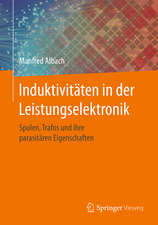Protective Relaying of Power Systems Using Mathematical Morphology: Power Systems
Autor Q.H. Wu, Zhen Lu, Tianyao Jien Limba Engleză Paperback – 22 oct 2010
| Toate formatele și edițiile | Preț | Express |
|---|---|---|
| Paperback (1) | 887.05 lei 6-8 săpt. | |
| SPRINGER LONDON – 22 oct 2010 | 887.05 lei 6-8 săpt. | |
| Hardback (1) | 1107.56 lei 6-8 săpt. | |
| SPRINGER LONDON – 19 mai 2009 | 1107.56 lei 6-8 săpt. |
Din seria Power Systems
- 18%
 Preț: 953.13 lei
Preț: 953.13 lei - 18%
 Preț: 783.98 lei
Preț: 783.98 lei - 20%
 Preț: 1002.48 lei
Preț: 1002.48 lei - 18%
 Preț: 1021.86 lei
Preț: 1021.86 lei - 18%
 Preț: 897.65 lei
Preț: 897.65 lei - 18%
 Preț: 788.72 lei
Preț: 788.72 lei - 18%
 Preț: 734.27 lei
Preț: 734.27 lei - 18%
 Preț: 902.36 lei
Preț: 902.36 lei -
 Preț: 563.51 lei
Preț: 563.51 lei - 18%
 Preț: 955.08 lei
Preț: 955.08 lei - 18%
 Preț: 946.87 lei
Preț: 946.87 lei - 18%
 Preț: 950.52 lei
Preț: 950.52 lei - 18%
 Preț: 949.23 lei
Preț: 949.23 lei - 15%
 Preț: 641.85 lei
Preț: 641.85 lei - 18%
 Preț: 1116.26 lei
Preț: 1116.26 lei - 18%
 Preț: 961.10 lei
Preț: 961.10 lei - 18%
 Preț: 1380.78 lei
Preț: 1380.78 lei - 15%
 Preț: 639.59 lei
Preț: 639.59 lei - 15%
 Preț: 641.03 lei
Preț: 641.03 lei - 18%
 Preț: 2497.51 lei
Preț: 2497.51 lei - 18%
 Preț: 957.62 lei
Preț: 957.62 lei - 18%
 Preț: 1229.91 lei
Preț: 1229.91 lei - 15%
 Preț: 643.34 lei
Preț: 643.34 lei - 18%
 Preț: 957.09 lei
Preț: 957.09 lei - 18%
 Preț: 1231.47 lei
Preț: 1231.47 lei - 15%
 Preț: 698.30 lei
Preț: 698.30 lei - 18%
 Preț: 953.20 lei
Preț: 953.20 lei - 15%
 Preț: 640.88 lei
Preț: 640.88 lei - 15%
 Preț: 634.18 lei
Preț: 634.18 lei - 18%
 Preț: 955.08 lei
Preț: 955.08 lei - 18%
 Preț: 1241.73 lei
Preț: 1241.73 lei - 18%
 Preț: 952.09 lei
Preț: 952.09 lei - 18%
 Preț: 946.55 lei
Preț: 946.55 lei - 18%
 Preț: 961.86 lei
Preț: 961.86 lei - 18%
 Preț: 944.19 lei
Preț: 944.19 lei - 18%
 Preț: 1110.72 lei
Preț: 1110.72 lei - 15%
 Preț: 642.03 lei
Preț: 642.03 lei - 15%
 Preț: 636.12 lei
Preț: 636.12 lei - 18%
 Preț: 1054.99 lei
Preț: 1054.99 lei - 15%
 Preț: 639.90 lei
Preț: 639.90 lei - 18%
 Preț: 957.32 lei
Preț: 957.32 lei - 18%
 Preț: 1235.57 lei
Preț: 1235.57 lei - 18%
 Preț: 959.19 lei
Preț: 959.19 lei
Preț: 887.05 lei
Preț vechi: 1081.77 lei
-18% Nou
Puncte Express: 1331
Preț estimativ în valută:
169.79€ • 184.49$ • 142.72£
169.79€ • 184.49$ • 142.72£
Carte tipărită la comandă
Livrare economică 22 aprilie-06 mai
Preluare comenzi: 021 569.72.76
Specificații
ISBN-13: 9781849968461
ISBN-10: 1849968462
Pagini: 208
Ilustrații: XXII, 208 p.
Dimensiuni: 155 x 235 x 12 mm
Greutate: 0.33 kg
Ediția:Softcover reprint of hardcover 1st ed. 2009
Editura: SPRINGER LONDON
Colecția Springer
Seria Power Systems
Locul publicării:London, United Kingdom
ISBN-10: 1849968462
Pagini: 208
Ilustrații: XXII, 208 p.
Dimensiuni: 155 x 235 x 12 mm
Greutate: 0.33 kg
Ediția:Softcover reprint of hardcover 1st ed. 2009
Editura: SPRINGER LONDON
Colecția Springer
Seria Power Systems
Locul publicării:London, United Kingdom
Public țintă
ResearchCuprins
Mathematical Morphology.- Phasor Measurement.- Protection of Transmission Lines.- Transformer Protection.- Bus Protection.- Ultra-High-Speed Protection.- Fault Location on Transmission Lines.
Notă biografică
Professor Q.H. Wu is the chair of Electrical Engineering at The University of Liverpool, UK. He obtained an MSc(Eng) in Electrical Engineering from Huazhong University of Science and Technology (HUST), China and a PhD in Electrical Engineering from The Queen's University of Belfast (QUB). Before joining The University of Liverpool Professor Wu worked at both QUB and Loughborough University, UK. In 1994 he was awarded the Donald Julius Groen Prize for the best paper published in the Journal of Systems and Control Engineering, Institution of Mechanical Engineers. Professor Wu’s research interests include systems modelling, adaptive control, mathematical morphology, evolutionary computation, multi-agent systems and their applications for power system operation and control.
Z. Lu received an MSc(Eng) in Electrical Engineering from Huazhong University of Science and Technology, China. He obtained a PhD degree from The University of Liverpool and is currently a postdoctoral research associate with the Department of Electrical Engineering and Electronics at the university. His research areas include power system protection, mathematical morphology and evolutionary computation.
T.Y. Ji has received a BA in English and an MSc(Eng) in Signal and Information Processing from Xi'an Jiaotong University, China. She is currently studying for a PhD at the Department of Electrical Engineering and Electronics, The University of Liverpool, UK. Her research areas include mathematical morphology, signal processing and evolutionary computation.
Z. Lu received an MSc(Eng) in Electrical Engineering from Huazhong University of Science and Technology, China. He obtained a PhD degree from The University of Liverpool and is currently a postdoctoral research associate with the Department of Electrical Engineering and Electronics at the university. His research areas include power system protection, mathematical morphology and evolutionary computation.
T.Y. Ji has received a BA in English and an MSc(Eng) in Signal and Information Processing from Xi'an Jiaotong University, China. She is currently studying for a PhD at the Department of Electrical Engineering and Electronics, The University of Liverpool, UK. Her research areas include mathematical morphology, signal processing and evolutionary computation.
Textul de pe ultima copertă
The basic operating principles of the most common types of protection relays have not changed for more than half a century. However, the calculations used to measure power system fault signals continue to cause problems with relay performance. As a result, there is a need for developing a next generation of protection relays which are more accurate, more reliable and faster than the conventional relays.
Protective Relaying of Power Systems Using Mathematical Morphology discusses the development of novel protective relaying algorithms using Mathematical Morphology (MM). MM is a nonlinear signal processing technique derived from set theory and geometry. It analyses signals in terms of shape by retrieving the features of the signals using a pre-defined structuring element. The book introduces the fundamental principles, and brings together the applications of MM to develop new protective relaying algorithms for the protection of a variety of power system components (including transmission lines, bus, and power transformers), as well as for the distorted waveform detection and compensation which are required for the operation of many conventional relays.
Protective Relaying of Power Systems Using Mathematical Morphology is an ideal source of information for researchers or postgraduates in the fields of power and engineering, as well as for power engineers.
Protective Relaying of Power Systems Using Mathematical Morphology discusses the development of novel protective relaying algorithms using Mathematical Morphology (MM). MM is a nonlinear signal processing technique derived from set theory and geometry. It analyses signals in terms of shape by retrieving the features of the signals using a pre-defined structuring element. The book introduces the fundamental principles, and brings together the applications of MM to develop new protective relaying algorithms for the protection of a variety of power system components (including transmission lines, bus, and power transformers), as well as for the distorted waveform detection and compensation which are required for the operation of many conventional relays.
Protective Relaying of Power Systems Using Mathematical Morphology is an ideal source of information for researchers or postgraduates in the fields of power and engineering, as well as for power engineers.
Caracteristici
Discusses the development of novel protective relaying algorithms using Mathematical Morphology (MM), a nonlinear signal processing technique derived from set theory and geometry Includes supplementary material: sn.pub/extras




















